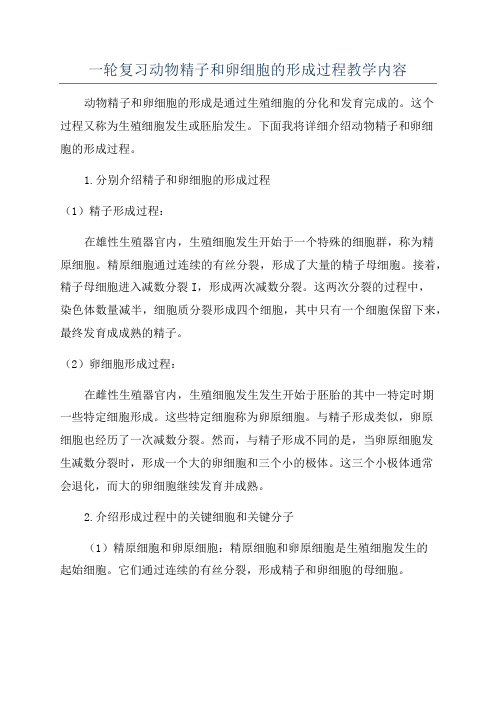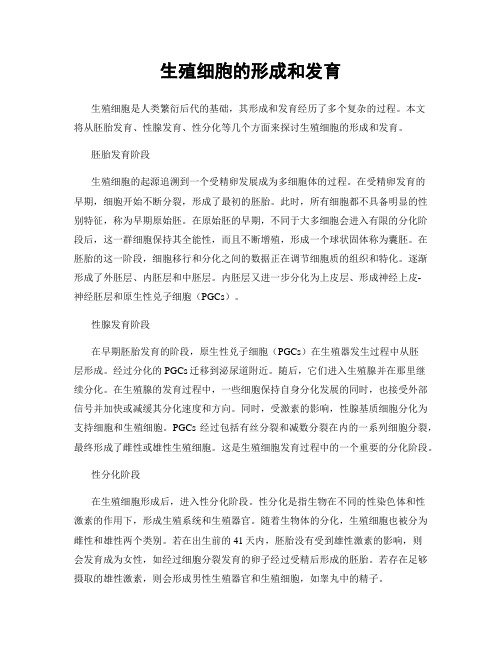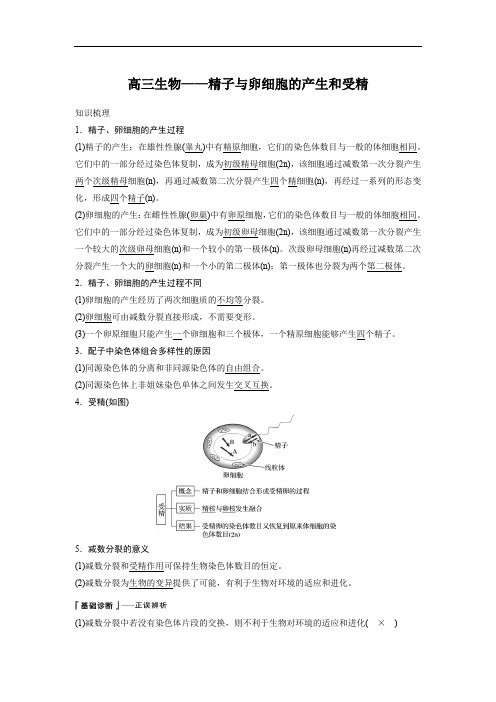III 生殖细胞发生与受精(I)
一轮复习动物精子和卵细胞的形成过程教学内容

一轮复习动物精子和卵细胞的形成过程教学内容动物精子和卵细胞的形成是通过生殖细胞的分化和发育完成的。
这个过程又称为生殖细胞发生或胚胎发生。
下面我将详细介绍动物精子和卵细胞的形成过程。
1.分别介绍精子和卵细胞的形成过程(1)精子形成过程:在雄性生殖器官内,生殖细胞发生开始于一个特殊的细胞群,称为精原细胞。
精原细胞通过连续的有丝分裂,形成了大量的精子母细胞。
接着,精子母细胞进入减数分裂I,形成两次减数分裂。
这两次分裂的过程中,染色体数量减半,细胞质分裂形成四个细胞,其中只有一个细胞保留下来,最终发育成成熟的精子。
(2)卵细胞形成过程:在雌性生殖器官内,生殖细胞发生发生开始于胚胎的其中一特定时期一些特定细胞形成。
这些特定细胞称为卵原细胞。
与精子形成类似,卵原细胞也经历了一次减数分裂。
然而,与精子形成不同的是,当卵原细胞发生减数分裂时,形成一个大的卵细胞和三个小的极体。
这三个小极体通常会退化,而大的卵细胞继续发育并成熟。
2.介绍形成过程中的关键细胞和关键分子(1)精原细胞和卵原细胞:精原细胞和卵原细胞是生殖细胞发生的起始细胞。
它们通过连续的有丝分裂,形成精子和卵细胞的母细胞。
(2)减数分裂:减数分裂是形成精子和卵细胞的关键分裂过程。
两次减数分裂导致染色体数量减半,确保了精子和卵细胞具有一半的染色体数量。
(3)极体:在卵细胞形成过程中,一个大的卵细胞和三个小的极体同时形成。
三个极体通常会退化,而大的卵细胞继续发育。
(4)染色体重组:在精子和卵细胞的形成过程中,染色体发生了重组。
这种重组通过染色体间的产生非姐妹染色单体的交换,导致基因重组,增加遗传多样性。
3.精子和卵细胞的功能和特点(1)精子:精子是雄性生殖细胞,具有能够游动和受精的能力。
它们通常较小,具有长尾巴,适合于在生殖道中游动到卵细胞处受精。
(2)卵细胞:卵细胞是雌性生殖细胞,具有能够受精和发育成为胚胎的能力。
卵细胞通常较大,具有丰富的营养贮备,为胚胎最初的发育提供能量和营养。
生殖细胞的形成和发育

生殖细胞的形成和发育生殖细胞是人类繁衍后代的基础,其形成和发育经历了多个复杂的过程。
本文将从胚胎发育、性腺发育、性分化等几个方面来探讨生殖细胞的形成和发育。
胚胎发育阶段生殖细胞的起源追溯到一个受精卵发展成为多细胞体的过程。
在受精卵发育的早期,细胞开始不断分裂,形成了最初的胚胎。
此时,所有细胞都不具备明显的性别特征,称为早期原始胚。
在原始胚的早期,不同于大多细胞会进入有限的分化阶段后,这一群细胞保持其全能性,而且不断增殖,形成一个球状固体称为囊胚。
在胚胎的这一阶段,细胞移行和分化之间的数据正在调节细胞质的组织和特化。
逐渐形成了外胚层、内胚层和中胚层。
内胚层又进一步分化为上皮层、形成神经上皮-神经胚层和原生性兑子细胞(PGCs)。
性腺发育阶段在早期胚胎发育的阶段,原生性兑子细胞(PGCs)在生殖器发生过程中从胚层形成。
经过分化的PGCs迁移到泌尿道附近。
随后,它们进入生殖腺并在那里继续分化。
在生殖腺的发育过程中,一些细胞保持自身分化发展的同时,也接受外部信号并加快或减缓其分化速度和方向。
同时,受激素的影响,性腺基质细胞分化为支持细胞和生殖细胞。
PGCs经过包括有丝分裂和减数分裂在内的一系列细胞分裂,最终形成了雌性或雄性生殖细胞。
这是生殖细胞发育过程中的一个重要的分化阶段。
性分化阶段在生殖细胞形成后,进入性分化阶段。
性分化是指生物在不同的性染色体和性激素的作用下,形成生殖系统和生殖器官。
随着生物体的分化,生殖细胞也被分为雌性和雄性两个类别。
若在出生前的41天内,胚胎没有受到雄性激素的影响,则会发育成为女性,如经过细胞分裂发育的卵子经过受精后形成的胚胎。
若存在足够摄取的雄性激素,则会形成男性生殖器官和生殖细胞,如睾丸中的精子。
总结通过以上的阐述,生殖细胞形成和发育分为胚胎发育、性腺发育和性分化三个阶段。
每个阶段都非常关键,直接影响到最终的生殖结果。
在未来的科学研究和医疗实践中,对生殖细胞的形成和发育等过程的理解和掌握将非常重要,将为人类繁衍后代打下基础。
12-13动物的繁殖和个体发育

黄体
人卵巢横切图示
排卵即是成熟卵泡破裂,初级卵母细胞及其外周的 透明带、放射冠细胞随卵泡液自卵巢排出的过程。
人类卵子结构示意图 注意:所谓的“排卵”排出的是真正的“卵”吗?
卵发生中的几个问题
• 人卵泡:初级卵母细胞及其周围的卵泡细胞 (滤泡细胞、放射冠),注意皮层颗粒、透 明带等结构
• 减数分裂中的两次停顿 • 女性不育:先天性卵巢发育不全征(p127)、
• 外生殖器包括阴茎和阴 囊等。
在人类中,男性精原细胞的减数分裂和精 子的形成直到青春期才在睾丸中开始。
人精子发生的几个问题
• 发生在曲细精管(从基膜向管腔内方向形成), 成熟在附睾
• 顶体是特化的溶酶体,来自高尔基复合体 • 尾部主要成分是由微管构成的鞭毛 • 男性不育:先天性睾丸发育不全征(p126)、精
精子和卵子的染色体畸变等
思考
• 人(与哺乳类)后代数量并不多,为何卵巢 内初级卵母细胞数量如此巨大?
待研究的问题: 为什么有些初级卵母细胞能继续发育,而 另些则不能? ─ 如何选择?选择的机制是什么?
二、受精
●精子和卵子结合成合子(受精卵)的过程。 ●受精条件
①精子、卵子的成熟 ★精子在附睾管道中停留12-21天才能获得主动运动和受精 的能力;在雌性生殖道内停留5-6h,精子获能。在体外条 件下,血清白蛋白、高密脂蛋白、氨基聚糖、孕酮、钙离 子载体(A23187)、CO2等均可促进精子获能。 ★雌性激素对卵细胞的成熟与运行至关重要,此时促卵泡 成熟激素(FSH)和促黄体生成素(LH)水平增高,诱导 卵泡发育成熟和排卵。
在卵子外围集聚有几十个精子,它们首先 通过顶体反应穿过第一道屏障----放射冠。
几个精子同时分解透明带,但只有一个精
生殖细胞的发生受精及意义

辅助生殖技术发展
随着辅助生殖技术的不断发展,如体外受精、胚胎移植等,为不孕不育患者提供了更多生育选择 ,同时也推动了生殖细胞发生受精研究的进展。
未来发展趋势预测
01
深入研究生殖细胞发育与调控机制
生殖细胞作为遗传信息的载体,在受精过程中实现了父母双方 遗传信息的交流。
02
通过生殖细胞的筛选和竞争,优秀的遗传信息得以传递,促进
了种群遗传信息的优化。
生殖细胞在发育过程中受到内外环境的影响,从而实现了遗传
03
信息与环境因素的相互作用和适应。
辅助生殖技术应用前景
生殖细胞的研究为辅助生殖技术提供了理论基础 和技术支持,如试管婴儿、克隆技术等。
未来研究将进一步揭示生殖细胞发育过程中的关键基因、信号通路及调
控网络,为生殖障碍的治疗提供理论基础。
02
探索新型辅助生殖技术
随着科技的不断进步,未来有望出现更加高效、安全的辅助生殖技术,
提高生育成功率和降低风险。
03
关注生殖健康与优生优育
生殖健康与优生优育是未来生殖医学领域的重要发展方向,将更加注重
提高公众认知度和接受度
加强科普宣传
通过科普讲座、宣传资料等多种 形式,向公众普及生殖细胞发生 受精的基本知识,提高公众对生 殖健康的认识和重视程度。
推广新型辅助生殖技术
积极推广新型辅助生殖技术,让 更多不孕不育患者了解并接受这 些治疗方法,提高生育成功率和 家庭幸福感。
关注伦理和社会问题
在推广生殖细胞发生受精研究成 果的同时,也要关注伦理和社会 问题,确保技术的合理应用和社 会的和谐发展。
生殖细胞的发生与分化

生殖细胞的发生与分化生殖细胞,也称为配子或性细胞,是人类繁殖的基本细胞单元,不仅负责繁殖的任务,还承载着父母的遗传物质,传递给下一代。
那么,人体内的生殖细胞是如何产生的呢?在人体内,生殖细胞的产生被称为生殖细胞发生,也叫生殖细胞分化。
生殖细胞发生从胚胎发育开始,分为两个流程:生殖细胞原始细胞分裂和生殖细胞中间体分裂。
一、生殖细胞原始细胞分裂首先,生殖细胞原始细胞分裂,这是生殖细胞产生的第一步。
生殖细胞原始细胞是一个未受精卵中的细胞,它位于卵巢或睾丸中,通过分裂、增殖、分化形成初级卵母细胞或精原细胞。
生殖细胞原始细胞分裂是一系列的细胞分裂和增殖过程。
在女性身体里,从胚胎到新生儿前,原始生殖细胞的活动主要发生在胚胎内的第5-17周内,大约分为三个时期:原始生殖细胞分裂增殖期、早期减数分裂期和成熟期。
在早期减数分裂期,卵母细胞被形成出来。
在男性身体里,原始生殖细胞分裂增殖期则延续到婴儿期,早期减数分裂期则在青春期开启,精原细胞被形成出来。
二、生殖细胞中间体分裂接下来,原始的生殖细胞要经历一系列的变化和分裂,来形成正常的生殖细胞。
在过程中,多次发生细胞分裂并伴有细胞核和染色体的数量减半,这被称为减数分裂。
减数分裂被认为是生殖细胞不可或缺的步骤,通过它生殖细胞携带的染色体数量得到了控制和维持,也实现了遗传基因信息的多样性。
在减数分裂过程中,卵母细胞的核分裂生成一个次级卵母细胞和一个极体,而精原细胞则产生四个精子。
次级卵母细胞再经过一次分裂,形成一个大细胞和另一个小细胞(第二个极体)。
小细胞会逐渐中断、凋亡消失。
大细胞就是成熟的卵子了,拥有一半染色体数量的单倍体状态,与被育发的精子相结合就形成新生命。
总的来说,生殖细胞的产生经历了许多复杂的步骤,它是细胞分化的一种形式。
通过生殖细胞分化,为我们的后代提供了必要的遗传信息,也保证了人类种群的繁衍生息。
虽然这个过程的具体细节非常复杂,但它存在的意义和生物学中的重要性是毋庸置疑的。
3 生殖细胞发生

二、原生殖细胞的迁移
原生殖细胞只有经过迁移,进入发育中 的生殖腺原基(genital anlage)——生殖嵴 (genital ridge)才能分化成为生殖细胞。
PGC在迁移过程中不断增殖,最终到达 性腺发育部位的PGC数量大大增加。
生殖嵴
概念:哺乳动物生殖嵴起源于中间中胚 层,具有双向性发育的特点。
(2)在秀丽线虫的卵精巢(ovotestis) 中,进行减数分裂的,先形成的最远端 的细胞形成卵子,而近端的细胞形成精 子。
线虫生精或生卵的分子机制
生殖细胞类型的选择
小鼠生殖细胞的类型主要决定于周边细胞的遗传组成
PGC进入生殖嵴的最初几天继续分裂,不分化。随后,在雌
性胚胎中,GC进入减数第一次分裂的前期,然后停止直到性
细胞分裂过程中细胞质的分裂不完全, 胞间有直径1μm的胞质间桥连接成合 胞体(syncytium)。胞间离子和分子通过 细胞质间桥相沟通,保证每群细胞同 步成熟.
雄性的Y染色体的性别决定基因SRY可以指导下 游基因Sox9和SF1的表达,二者都可以促进抗 中肾旁管激素表达,使生殖嵴获得发育为睾丸 的命运;在雌性个体中,DAX1基因是X染色体 上的卵巢决定基因,可以使生殖嵴获得发育为 卵巢的命运。
1. 果蝇原始生殖细胞的迁移
果蝇原始生殖细胞起源于胚胎的后端,经后中肠穿过肠壁和中胚 层,形成两个分离的队列,最终聚集在生殖腺中。
精子发生
脊椎动物的PGCs到达雄性胚胎的生殖腺原基后,立即 进入性索,然后停留在那里直到成熟。性索发育成为 生精小管,其管上皮细胞分化形成支持细胞(sertoli cell)。PGCs分裂形成精原细胞。
精原细胞(spermatogonium) →初级精母细胞(primary spermetocyte), →次级精母细胞(secondary spermatocyte)。→精子细胞(spermatid) →精子(sperm)。
生殖系统生殖细胞的形成与生殖过程

生殖系统生殖细胞的形成与生殖过程生殖系统是人体中的一个重要系统,它主要负责生殖细胞的形成和生殖过程。
生殖细胞是指男性的精子和女性的卵子,它们在生殖系统中经历一系列的过程来形成和完成繁殖。
一、精子的形成与生殖过程精子的形成主要发生在男性的睾丸内,这个过程被称为精子发生。
具体步骤如下:1. 原始生殖细胞分裂:在胚胎时期,原始生殖细胞经过一系列的分裂和增殖,形成大量的生殖细胞。
2. 减数分裂:原始生殖细胞进一步发育,经过第一次减数分裂,形成两个次生生殖细胞。
3. 第二次减数分裂:次生生殖细胞再次发生减数分裂,形成四个精子细胞。
4. 成熟过程:四个精子细胞进一步成熟,形成四个有运动能力的精子。
精子的形成过程以及细胞的减数分裂保证了每个精子只含有半套染色体,保证了受精过程中染色体数量的正常。
精子形成后,会进入附睾等输精管道,待遇到适当的时机,通过射精进入女性生殖系统进行受精。
二、卵子的形成与生殖过程卵子的形成主要发生在女性的卵巢内,这个过程被称为卵子发生。
具体步骤如下:1. 卵子发育:在女性的卵巢中,原始生殖细胞发育为初级卵母细胞。
2. 第一次减数分裂:初级卵母细胞发生第一次减数分裂,形成一个较大的卵细胞和一个极小的极体细胞。
3. 第二次减数分裂:较大的卵细胞再次发生减数分裂,形成一个较大的卵细胞和一个较小的第二极体细胞。
4. 成熟过程:较大的卵细胞发育成为成熟卵子,成熟卵子含有充足的细胞质和遗传物质,准备进行受精。
卵子的形成过程中,第一次减数分裂的不对称性使得卵子中包含了大部分的细胞质和遗传物质,从而为受精和胚胎的发育提供了足够的营养和遗传物质。
卵子形成后,会进入输卵管,并等待精子的到来进行受精。
三、受精过程与胚胎发育受精过程是精子和卵子相遇、融合,并形成受精卵的过程。
具体步骤如下:1. 精子进入卵子:精子经过运动途径进入女性生殖道,穿过阻碍层,最终进入输卵管。
2. 受精卵形成:在输卵管中,精子与卵子相遇和融合,形成受精卵。
细胞的生殖与受精作用

细胞的生殖与受精作用细胞是构成生物体的基本单位,而细胞的生殖与受精作用是维持生物种群繁衍的重要过程。
通过细胞的有性与无性生殖方式,生物能够增加个体数量、保持遗传信息稳定以及产生适应性变异。
本文将探讨细胞的生殖与受精作用的基本概念、机制与重要意义。
一、细胞的生殖方式1. 有性生殖有性生殖是指细胞通过染色体的交换和重组形成不同的遗传组合,从而产生由两个亲本细胞融合而成的新细胞。
典型的有性生殖包括减数分裂和受精过程。
2. 无性生殖无性生殖是指细胞通过自我复制或分裂产生与其亲本细胞遗传基本相同的新细胞。
无性生殖常见的方式有二分裂、萌芽、孢子形成等。
二、细胞的受精作用受精是指雄性与雌性生殖细胞的结合,形成受精卵或受精子。
在受精过程中,生物体的遗传信息得以传递和结合,同时也产生了遗传的多样性。
1. 细胞受精的基本过程细胞受精的基本过程包括精子与卵细胞的结合、染色体的融合和形成受精卵等阶段。
在受精过程中,雄性生殖细胞通过运动途径到达雌性生殖细胞的位置,并与之结合形成受精卵。
2. 细胞受精的意义细胞受精的最终结果是形成受精卵,其中蕴含着新生生物的全部遗传信息。
细胞受精不仅能够保证物种的繁衍,还能增加遗传变异的可能性,使得后代具备适应环境的能力。
三、细胞生殖与受精的重要意义1. 维持物种繁衍细胞的生殖与受精作用是维持物种数量和种群稳定的重要方式。
通过有性生殖,物种能够产生具有遗传差异的后代,增加个体数量并适应环境变化。
2. 保持遗传信息细胞的受精作用有助于保持遗传信息的稳定性。
雄性与雌性生殖细胞的结合使得基因组发生染色体重组和重配过程,有利于修复和减少遗传缺陷。
3. 促进遗传多样性细胞的受精作用是遗传多样性的基础,通过产生具有不同基因组的后代,使得物种对环境的适应性更强,有利于物种的生存和进化。
总结:细胞的生殖与受精作用是生物繁衍的关键过程。
有性生殖通过染色体的交换与重组增加了遗传多样性,维持了物种繁衍和遗传信息的稳定性。
哺乳动物生殖细胞的发生和受精作用

新生命的第四天——胚泡
受精后8天。胚芽 完成"着陆",微微 嵌入子宫内膜。 此时它分裂发育 为几百个细胞。
囊胚:细胞开始分 化;内细胞团将来 发育成各种组织, 滋养层将来发育成 胎膜、胎盘;出现 囊胚腔后,进一步 扩大会导致孵化。
胚胎期:从第二周至第八周
第三周末形成原肠胚:内细 胞团表皮的细胞形成外胚层, 下方的细胞形成内胚层,出 现原肠腔。 新生命的第四周 新生命的第五周——看 啊,眼的雏形出来了
减数第二次分裂时间是在精子和卵子结合的 过程中,结果是产生1个成熟卵子和第二极体。
(卵泡细胞或卵丘细胞群)
(一种糖蛋白)
(卵黄膜)
三、精子与卵子的发生比较
精 子
卵 子
开始 细胞增殖方式 时间 睾丸 初情 先有丝分裂 期以 后减数分裂 后 卵巢 性别 先有丝分裂 分化 后减数分裂 输卵管 以后
场所
多个精原细胞
有丝分裂
精原细胞经过有丝分裂产 生多个初级精母细胞。
初级精母细胞
MⅠ
染色体复制 初级精母细胞经减数分 裂形成含有单倍染色体 的精子细胞。
次级精母细胞
MⅡ
精子细胞
变形
精子
细胞核变为精子头部 的主要部分; 高尔基体发育为头部 的顶体; 中心体演变为精子的 尾; 线粒体形成线粒体鞘 膜; 其它物质浓缩成原生 质滴(球形)
(二)、卵子的发生
1、场所:卵巢、输卵管
卵巢中卵子发生过程
2、过程:减数分
裂间期
雌性胎儿卵巢内的卵原细胞,通过有丝分裂 增加其数量,演变为初级卵母细胞,被卵泡细胞 包围形成卵泡。初级卵母细胞经过减数分裂变为 成熟的卵子。 减数第一次分裂时间是在雌性动物排卵前后 完成的,结果是产生1个次级卵母细胞和第一极体。
第一章生殖细胞的发生

人卵细胞的成熟过程
原始生 殖细胞
卵母细胞处于 每周期有一组 MI的双线期 卵母细胞发育
卵原细胞 初级卵母细胞
次级卵母细胞
原始卵泡 生长卵泡 成熟卵泡
胎儿期
胎儿出 生前后
青春期
人类卵巢中生殖细胞数目的变化
卵细胞成熟发育中极体形成
卵细胞发育模式的多样性
卵细胞存在发育分化的休眠和滞 留现象
卵细胞的成熟有周期变化现象 减数分裂极体可被再利用,并可
翻译RNA分子 5 除此之外,还发现起码有另7种基因,它
们的突变将干扰极颗粒的正确定位,从 而影响到生殖干细胞的发生。
2、两栖类动物卵的发育
两栖类卵子由卵原细胞分化而来,卵子发 生时间较长。爪蟾减数分裂细线期可持续 3-7天,偶线期5-9天,粗线期约3周,双线 期则持续几年,此时部分细胞进入卵黄发 生阶段。由于卵质内含物的不均匀分布导 致卵子的极性,成熟卵中植物极卵质中卵 黄浓度远高于动物极,但卵质膜对卵黄蛋 白原的摄入是均一的 ,产生这种极性分布 的原因是卵黄小板的移动。
爪蟾卵细胞卵黄物质的极性积累
蛙 卵 母 细 胞 的 生 长
3、哺乳动物卵的发育
哺乳动物卵细胞成熟方式可分为两种类型: 1. 交配过程刺激诱发垂体分泌促性腺激素,
导致休眠卵细胞苏醒完成减数分裂和释 放受精卵。(兔子、水貂) 2. 绝大多数哺乳动物有固定的发情期,由 环境的刺激触发下丘脑产生促性腺激素 释放因子,进而引发卵巢滤泡细胞生理 变化和休眠卵细胞的继续发育和释放。
第一章 生殖细胞的发生
第一节 生殖细胞的起源与分化
一、 生殖质与原始生殖细胞
生殖质(germ plasm):是卵子细胞质内具有 一定形态结构的、决定生殖细胞形成的特殊 胞质,由RNA和蛋白质组成。随着胚胎发育 的进行,生殖质逐渐被分配到一定的细胞中 , 这些细胞最终分化为PGC。
2023年关于1自然受精的全过程

自然受精的全过程自然受精的全过程(上)自然受精是指在动物繁殖过程中,雄性生殖细胞与雌性生殖细胞结合,形成受精卵的过程。
这个过程在多数动物中都是相似的,下面将以人类为例来介绍自然受精的全过程。
自然受精的过程可以分为三个阶段:Ⅰ、生殖细胞的生成;Ⅱ、生殖细胞的成熟;Ⅲ、受精与胚胎发育。
下面详细介绍每个阶段的过程。
Ⅰ、生殖细胞的生成生殖细胞的生成发生在男性与女性身体的不同部位。
对于男性来说,生殖细胞的生成发生在睾丸中。
在青春期开始时,睾丸开始分泌睾酮激素,促进精子的生成。
一般来说,成熟的精子会在睾丸的附睾中暂时储存。
对于女性来说,生殖细胞的生成发生在卵巢中。
女性在胚胎发育期就已经具有一定数量的卵母细胞。
当女性进入青春期时,卵母细胞开始成熟。
从卵巢中一个被称为卵泡的小囊泡中,每月释放出一个成熟的卵子。
Ⅱ、生殖细胞的成熟在进入第二个阶段之前,生殖细胞需要经过成熟的过程。
对于男性来说,生殖细胞的成熟主要发生在附睾中。
在附睾中,精子的头部会形成一个特殊的鞘状结构,帮助精子在受精过程中穿透卵子的外膜。
对于女性来说,生殖细胞的成熟主要发生在卵巢中的卵泡。
在每个月的排卵期,一个卵泡会发育成为成熟的卵子。
在成熟的过程中,卵泡会分泌雌激素,促进子宫内膜的生长,为受精卵的着床做准备。
Ⅲ、受精与胚胎发育生殖细胞的成熟后,雄性与雌性的生殖细胞会在受精器官中相遇,完成受精的过程。
在人类中,受精一般发生在女性的输卵管中。
当雄性生殖细胞(精子)进入女性体内时,通过移动和顺应性变形,最终会找到卵子并与之结合。
受精完成后,形成的受精卵会顺着输卵管下降,并进入子宫。
在这个过程中,受精卵会不断分裂成多个细胞,形成一个小球状的胚胎。
胚胎会在几天内进一步发育,其中一部分细胞会分化成胚胎的外层细胞,形成胎盘,为胚胎提供养分和氧气。
胚胎进一步发育后,会在子宫内着床。
这意味着胚胎的固定和进一步发育将在子宫内完成。
一旦胚胎成功着床,逐渐形成胚胎囊,母体体内会分泌孕激素,维持和促进胚胎的继续发育。
高三生物——精子与卵细胞的产生和受精

高三生物——精子与卵细胞的产生和受精知识梳理1.精子、卵细胞的产生过程(1)精子的产生:在雄性性腺(睾丸)中有精原细胞,它们的染色体数目与一般的体细胞相同。
它们中的一部分经过染色体复制,成为初级精母细胞(2n),该细胞通过减数第一次分裂产生两个次级精母细胞(n),再通过减数第二次分裂产生四个精细胞(n),再经过一系列的形态变化,形成四个精子(n)。
(2)卵细胞的产生:在雌性性腺(卵巢)中有卵原细胞,它们的染色体数目与一般的体细胞相同。
它们中的一部分经过染色体复制,成为初级卵母细胞(2n),该细胞通过减数第一次分裂产生一个较大的次级卵母细胞(n)和一个较小的第一极体(n)。
次级卵母细胞(n)再经过减数第二次分裂产生一个大的卵细胞(n)和一个小的第二极体(n);第一极体也分裂为两个第二极体。
2.精子、卵细胞的产生过程不同(1)卵细胞的产生经历了两次细胞质的不均等分裂。
(2)卵细胞可由减数分裂直接形成,不需要变形。
(3)一个卵原细胞只能产生一个卵细胞和三个极体,一个精原细胞能够产生四个精子。
3.配子中染色体组合多样性的原因(1)同源染色体的分离和非同源染色体的自由组合。
(2)同源染色体上非姐妹染色单体之间发生交叉互换。
4.受精(如图)5.减数分裂的意义(1)减数分裂和受精作用可保持生物染色体数目的恒定。
(2)减数分裂为生物的变异提供了可能,有利于生物对环境的适应和进化。
(1)减数分裂中若没有染色体片段的交换,则不利于生物对环境的适应和进化(×)(2)减数分裂中发生均等分裂的细胞有可能是极体(√)(3)高等动物产生精子或卵细胞的过程中,只有非同源染色体上基因之间发生的自由组合属于基因重组(×)(4)正常情况下,在人的初级卵母细胞经减数分裂形成卵细胞的过程中,一个细胞中含有的X 染色体条数最多为4条(×)(5)若细胞中含有1 条Y染色体,则可确定该细胞为初级精母细胞(×)(6)精子和卵细胞的相互识别是通过细胞的直接接触完成的(√)(7)受精卵中的染色体和遗传物质均有一半来自父方,一半来自母方(×)(8)受精作用实现了基因重组,造成有性生殖后代的多样性(×)(9)受精的实质是精子进入卵细胞中(×)1.减数分裂过程中的相关曲线图与柱形图(以精子形成为例)(1)甲为精原细胞;乙为初级精母细胞;丙、丁为次级精母细胞;戊为精细胞。
哺乳动物生殖细胞的发生和体内受精

2、动物受精作用的实质是
()
D
A.精子和卵细胞的相互识别 B.精子的头部进入到卵
细胞内 C.一个卵细胞只能与一个精子结合 D.卵细胞
的细胞核与精子的细胞核相互融合
3、关于受精过程的叙述错误的是 ( ) A
A.获能后的精子与卵子相遇后,释放顶体酶穿过透明
带进入放射冠
B.透明带反应是防止多精入卵的第一道屏障
2)卵子的准备:卵子在受精前也要经历类似 精子获能的过程,原因中动物排出的卵子 成熟程度不同。在输卵管中卵子发育到减 数第二次分裂的中期,才具有与精子受精 的能力。
Ⅱ、受精阶段:
1)精子穿越放射冠和透明带
顶体反应使顶体内的酶释放出来并溶
解放射冠内的卵丘细胞
透明带反应是防止多精入卵受精的第
一道屏障
2)精子进入卵细胞膜
注意
受精的标志?受精完成的标志? 在卵黄膜和透明带的间隙可以观察到两个极体。 雄雌原核融合,形成一个含二倍染色体的合子
1、关于高等动物受精作用的叙述,错误的是( D)
A.受精作用发生在输卵管
B.精子和卵子的结合过程中,卵子完成减数第二次分裂
C.精子细胞膜与卵子细胞膜融合依靠了细胞膜结构的特点
D.精子与卵子相遇后,会发生顶体反应,防止多精入卵
生命观念: 以精子和卵细胞的结构 为例,阐述细胞的结构与功能相 适应。
科学思维:以精子的运行途径为线索, 设计一幅简图,说明哺乳动物的 受精过程。
探究二: 认真阅读课本P63-P65,回 答以下问题:
• 1. 受精过程中的三大反应是什么? • 2. 防止多精入卵的两道屏障? • 3. 卵子受精的标志和受精完成的标志? • 4. 分析受精卵的遗传物质。
• (3)当__雌__雄_原__核_充__分_发__育_,__彼_此__融__合_成__合_子___时,受精过程至 此结束。
生殖系统生理学生殖细胞发生与性激素作用

生殖系统生理学生殖细胞发生与性激素作用生殖系统生理学:生殖细胞发生与性激素作用生殖系统是人体的一个重要组成部分,它负责生殖细胞的发生和性激素的作用。
生殖细胞发生是指在生殖器官内,雄性和雌性细胞通过不同的过程形成。
而性激素则是一类重要的内分泌物质,对于性别发育和生殖功能的发挥起着至关重要的作用。
本文将从生殖细胞发生以及性激素的作用两个方面来介绍生殖系统的生理学知识。
一、生殖细胞发生1. 男性生殖细胞发生男性生殖细胞发生发生在睾丸内的睾丸小管中。
在这里,睾丸细胞通过减数分裂和减数分裂二次形成了精子。
精子在发生过程中,经历了增殖期、成熟期和分化期。
增殖期是指睾丸细胞通过有丝分裂增殖,形成了大量的原生精子细胞。
成熟期是指原生精子细胞发生减数分裂,形成了四个单倍体的精子。
最后,在分化期,精子经历了形态改变和脱离上皮细胞的过程,最终成熟为功能完整的精子。
2. 女性生殖细胞发生女性生殖细胞发生发生在卵巢内的卵泡中。
在女性的胚胎发育过程中,原始生殖细胞发育为卵母细胞。
卵母细胞经过减数分裂形成一小部分初级卵母细胞,而在青春期后每个月都会从初级卵母细胞中选择并发育出一个卵泡。
在排卵期,成熟的卵泡会被释放出来,然后与精子相结合形成受精卵。
二、性激素的作用1. 雄性激素的作用雄性激素主要由睾丸分泌,其中最重要的是睾酮。
雄性激素对男性性发育具有重要的作用,促使男性次级性征的发育,如喉结增大、声音变低、肌肉发达等。
此外,雄性激素还促进了精子的产生和睾丸的发育。
2. 雌性激素的作用雌性激素主要由卵巢分泌,其中最重要的是雌二醇。
雌性激素对女性性发育具有关键的作用,促进了女性次级性征的形成,如乳房发育、骨骼的发育等。
此外,雌性激素还对月经周期的调节和子宫的发育起到重要的作用。
性激素除了对性别发育具有重要的作用外,还对性欲、性行为和生殖系统的功能维持起到调节作用。
这些作用是通过性激素与性激素受体的结合来实现的。
总之,在生殖系统中,生殖细胞的发生与性激素的作用密不可分。
- 1、下载文档前请自行甄别文档内容的完整性,平台不提供额外的编辑、内容补充、找答案等附加服务。
- 2、"仅部分预览"的文档,不可在线预览部分如存在完整性等问题,可反馈申请退款(可完整预览的文档不适用该条件!)。
- 3、如文档侵犯您的权益,请联系客服反馈,我们会尽快为您处理(人工客服工作时间:9:00-18:30)。
The germ cell development and fertilization
1 The germ cell fate determination and development of gonads
1.1 Specification and determination of the primordial germ cells (PGCs) 1.2 The germ cell migration and development of gonads 2 Gametogenesis 2.1 Spermatogenesis 2.2 Oogenesis 3 Fertilization 3.1 The recognition of egg and sperm 3.2 The prevention of polyspermy 3.3 The activation of egg metabolism
Germ cell specification in the mouse involves cell-cell interactions
pole of the cellularizing blastoderm. The pole plasm (极质)at the posterior pole is critical for determination of the PGCs in flies. The pole plasm includes several components that are crucial for the PGC determination. Those are mRNA of gcl (germ cell less) gene, Oskar, Nanos, Vasa, mitochondrial ribosomal RNA (mtr RNA) etc.
The molecular mechanisms underlying the specification and determination of the PGCs in Drosophila (II)
In Drosophila, several maternal gene (at least 8 genes) are functionally
There
is no obvious germ plasm in mammals, and mammalian germ cells are not morphologically distinct during early development. Rather, germ cells are induced in gastrulating embryos
The gene oskar is sufficient to specify the germ cells in Drosophila
Functionally conserved genes in Germ-Cell Development
Origin of the PGCs in mammals
In
mice, the germ cells form at the posterior region of the epiblast, at the junction of the extraembryonic ectoderm, epiblast, primitive streak, and allantois.
The germ cell development and fertilization
1 The germ cell fate determination and development of gonads
1.1 Specification and determination of the primordial germ cells (PGCs) 1.2 The germ cell migration and development of gonads 2 Gametogenesis 2.1 Spermatogenesis 2.2 Oogenesis 3 Fertilization 3.1 The recognition of egg and sperm 3.2 The prevention of polyspermy 3.3 The activation of egg metabolism
In mice, At day 6.5 of embryonic development, BMP4 and BMP8b
from the extraembryonic ectoderm give certain cells in this area the ability to produce germ cells.
Germ
plasm can be identified morphologically by the presence of conspicuous membrane-unbound organelles with an electrondense granulofibrillar appearance called germ granules
Origin of the PGCs in Drosophila
The PGCs known as pole cells become distinct at the posterior pole of the egg about 90 minutes after fertilization. The cytoplasm at the posterior pole is called pole plasm and is distinguished by large organelles, the polar granules, which contains both proteins and mRNAs
The pole plasm includes several components that are crucial for the
PGC determination. Those are mRNA of gcl (germ cell less) gene, Oskar, Nanos, Vasa, mitochondrial ribosomal RNA (mtr RNA) etc.
The molecular mechanisms underlying the specification and determination of the PGCs in Drosophila (I)
In Drosophila, the PGCs form as a group of pole cells at the posterior
The adult gonads and early development of the fertilized egg in C elegans
The cell lineage chart in the development of C elegans
558 cells present in the newly hatched larva, 959 somatic cells in the adult
There is no evidence for germ plasm being involved in germ cell
formation in the mouse or other mammals. Instead, germ cell specification in the mouse involves cell-cell interactions.
The mammalian PGCs appear to be induced in the early gastrulating embryos
The molecular mechanisms underlying the specification and determination of al germ cells differentiated into eggs and sperm? (including meiosis)
Fertilization
and activation of the egg by the sperm that initiates the embryonic development.
P granules in C. elegans
Polar granules in Drosophila Germinal granules in Xenopus
The germ cell fate of C. elegans is determined at the 16-cell embryo
Developmental Biology
Chapter 3: The germ cell development and fertilization
The germ cell development and fertilization
How How
are the germ cells specified and determined?
necessary and sufficient for the pole plasm formation, and the germ cell specification/determination
Mutations in any of those genes, e.g oskar, result in the affected homozygous individual being “grandchildless”. Its offsprings (F1) lack a proper pole plasm, and although they may develop normally in other ways, they lack germ cells and therefore are sterile (F2). Expression of oskar alone is sufficient for ectopically specifying the germ cells
